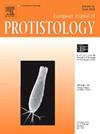PCNA's dual legacy in ciliates: Conserved replication scaffold and lineage-specific genome architect
IF 1.6
2区 生物学
Q4 MICROBIOLOGY
引用次数: 0
Abstract
Proliferating cell nuclear antigen (PCNA) is a central scaffold in eukaryotic DNA replication, repair, and epigenetic regulation. While its roles are well-characterized in canonical model organisms, ciliates, unicellular eukaryotes with nuclear dimorphism and programmed genome remodeling, offer unparalleled insights into PCNA's functional adaptability. Their unique biology, including replication-coupled DNA elimination, macronuclear amplification, and replication band dynamics, positions PCNA at the intersection of genome stability and plasticity. This review systematically compares ciliate and human PCNA through phylogenetic, structural, and functional analyses. We reveal that ciliate PCNAs, despite ∼50 % sequence divergence from mammals, preserve conserved trimerization interfaces and partner-binding motifs, as validated by AlphaFold3-predicted models of the classical model organism Tetrahymena thermophila and the emerging systems Euplotes eurystomus and Stylonychia lemnae. Functional summaries highlight lineage-specific innovations, including epigenetic regulation, paralog specialization for nuclear differentiation, and replication band assembly. These findings have broader implications for elucidating replication-coupled chromatin dynamics, the adaptive evolution of multiprotein complexes, and the use of non-model organisms such as E. eurystomus and S. lemnae to uncover conserved principles of genome biology.
PCNA在纤毛虫中的双重遗产:保守的复制支架和谱系特异性基因组架构
增殖细胞核抗原(PCNA)是真核生物DNA复制、修复和表观遗传调控的中心支架。虽然它的作用在典型模式生物中很好地表征,但纤毛虫,具有核二态性和程序化基因组重塑的单细胞真核生物,为PCNA的功能适应性提供了无与伦比的见解。它们独特的生物学特性,包括复制偶联DNA消除、大核扩增和复制带动力学,使PCNA处于基因组稳定性和可塑性的交叉点。本文通过系统发育、结构和功能分析,系统地比较了纤毛虫和人类的PCNA。我们发现,尽管与哺乳动物的序列差异约为50%,但纤毛虫的PCNAs保留了保守的三聚化界面和伴侣结合基序,这一点得到了经典模式生物嗜热四膜虫(Tetrahymena thermophila)和新兴系统eurystomus和Stylonychia lemnae的alphafol3d预测模型的验证。功能总结强调谱系特异性创新,包括表观遗传调控、核分化的平行特化和复制带组装。这些发现对于阐明复制偶联染色质动力学、多蛋白复合物的适应性进化以及利用非模式生物(如E. eurystomus和S. lemnae)揭示基因组生物学的保守原理具有更广泛的意义。
本文章由计算机程序翻译,如有差异,请以英文原文为准。
求助全文
约1分钟内获得全文
求助全文
来源期刊

European journal of protistology
生物-微生物学
CiteScore
4.60
自引率
20.70%
发文量
55
审稿时长
14.6 weeks
期刊介绍:
Articles deal with protists, unicellular organisms encountered free-living in various habitats or as parasites or used in basic research or applications. The European Journal of Protistology covers topics such as the structure and systematics of protists, their development, ecology, molecular biology and physiology. Beside publishing original articles the journal offers a forum for announcing scientific meetings. Reviews of recently published books are included as well. With its diversity of topics, the European Journal of Protistology is an essential source of information for every active protistologist and for biologists of various fields.
 求助内容:
求助内容: 应助结果提醒方式:
应助结果提醒方式:


